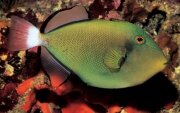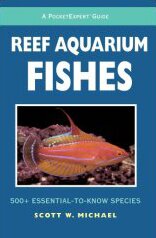Introduction: PocketExpert Reef Aquarium Fishes
From Microcosm Aquarium Explorer
Contents |
Fishes & Invertebrates: A Fine Balance
To me, a reef tank without fishes is like a flower garden without birds, butterflies, squirrels and other life forms.
Sessile invertebrates, such as stony corals, have a limited behavior repertoire, to say the least, and many display little if any movement. (I have yet to see a hyperactive sponge, for example.)
Fishes add movement and bring their “personalities” and fascinating behaviors to the aquascape, providing flashes of color and greatly enhancing the overall impression of the captive reef being an accurate reflection of a scene in the wild.
The Right Fishes for the Right Reef
However, as marine aquarium keepers master the husbandry skills to maintain, grow, and even propagate corals and other delicate invertebrates, reef fishes sometimes find themselves forgotten—or even banned from some systems. To succeed with corals and other invertebrates, it is vital to provide optimal water quality and eradicate or control pests or predators that prey on their polyps or delicate, exposed tissues.
For this reason, some coral enthusiasts recommend that you introduce few, if any, fishes to the reef aquarium. Fishes and their foods inevitably add to the nutrient load of the tank, thus challenging water quality, and some species may even pick at or eat coral polyps. While an overload of fishes—or the wrong kind of fishes—can overwhelm a reef aquarium, the right fishes can help in many ways: feeding on pests and parasites, grazing on nuisance algae, sifting the substrate, helping to keep the tank cleaner, and in some cases, even nurturing the corals and anemones with which they may associate.
I believe that the true measure of reefkeeping success today is finding a balance between fishes and invertebrate life, providing as realistic as possible an approximation of a scene in nature.
Fledgling Science
The more I’ve experimented with fishes in reef aquariums, the more I realize that finding fishes that will coexist with captive corals is still a very inexact science.
There are many extremely attractive, durable and reef-safe fish choices, and this guide will attempt to direct the new or intermediate aquarist to the families, genera, and species that have passed the tests of time in captive marine systems.
However, adventuresome reefkeepers are often looking for the unusual or unexpected fish species and may be willing to push the boundaries of what is truly “safe” when assembling their own marine aquarium communities. Coral reef fishes can also be idiosyncratic—well-behaved in some aquariums, exhibiting troublesome habits in others. This guide will attempt to flag the possible troublemakers, as well as the difficult-to-keep species, before you buy them.
Six Things to Consider
When Selecting a Fish for Your Reef Aquarium
1. Will it eat or nip the invertebrates you intend to keep? The first thing to look at in determining if a particular fish species may be a risk to your invertebrates is its natural diet. If a fish eats coral in the wild, it will most likely do so in the aquarium. If a fish eats shrimp and small fish on the reef, it will probably slurp up all your Blue Green Chromis and cleaner shrimp if it is large enough to do so.
Unfortunately, in the aquarium, some fish develop predilections for foods that they typically will ignore in the wild. Because certain fishes are a threat to some invertebrates and not to others, you will need to decide what types of invertebrates you want to keep in order to determine what species of fish are suitable for your tank. Once you decide on the animals to be included in your invertebrate community, you can then rule out certain fish species.
2. Will it knock or flip corals over? When a fish dislodges a piece of coral, the cnidarian’s tissue may be torn or it may land on another stinging coral or anemone, resulting in irreparable damage. There are species simply too large and rambunctious for the average home reef tank, and there are also fishes that commonly knock corals over when they forage over the reef. Others will take pieces of coral in their mouths or use chin barbels to flip them over when exposing hidden prey. One way to reduce the damage these species may cause is to use some of the underwater epoxies that are now available to reefkeepers to cement pieces of live rock together or to cement coral pieces to the live rock.
3. Will it constantly perch on or wallow in your corals? Special precautions need to be taken with species that perch on corals or that wallow among the tentacles of large-polyped stony corals. Anemonefishes will regularly wallow in the extended polyps of certain species, which sometimes causes the polyps to contract and can lead to the demise of the invertebrate.
4. Will it cover corals with sand substrate when it feeds or burrows? Some fishes may bury your invertebrates as a result of their feeding or burrowing activities. The fishes that are most likely to do this are the sleeper gobies (Valenciennea species). They take large mouthfuls of sand and eject it out through their gills, and some species rise into the water column before expelling the substrate. If you keep a substrate-sifting goby, you should not keep soft corals (many have a difficult time shedding sand) and species of stony corals that are intolerant of silting well away from the aquarium bottom. Place stony corals on the bottom that can easily shed sediment (e.g., Alveopora, Catalaphyllia, Cynarina, Goniopora, Fungia, Heliofungia, Herpolitha, Polyphyllia, Scolymia, and Trachyphyllia) and tilt them at a slight angle that will facilitate shedding. Promptly remove sand from those corals that cannot do it themselves—a turkey baster does this task nicely. Other sessile invertebrates that may be harmed by having substrate deposited on them include mushroom anemones, zoanthids, and clams.
5. How frequently will this fish have to be fed? Some reef aquarists feed their aquariums only two or three times a week, depending on the ability of the live rock to provide a sufficient diet of fauna and flora for the fishes. Increased feeding can result in poorer water quality (especially if your tank does not have a proper protein skimmer and/or adequate refugium) and therefore a less healthy environment for your invertebrates. But some of the fishes that feed principally on suspended zooplankton need to be fed at least once, and even twice, a day if they are gong to thrive in captivity.
These include anthias (Pseudanthias species), fairy wrasses (Cirrhilabrus species), flasher wrasses (Paracheilinus species), pyramid butterflyfishes (Hemitaurichthys species), and swallowtail angelfishes (Genicanthus species). If you are resolved to feeding your aquarium less than twice a day, avoid species in these groups. If you would like to keep some of these zooplankton feeders, use a large protein skimmer and live sand to control dissolved organic and nitrate levels that may result from increased feeding. Consider the use of a plant-filled refugium to extract dissolved nutrients and also to serve as a breeding ground for amphipods and other live foods that can help sustain your fishes.
6. Is this fish disease-resistant? Although no fish is totally immune to all the parasites common to marine aquariums, some species are less likely to succumb to parasites. For example, the comets (Calloplesiops species) are incredibly hardy and rarely, if ever, have problems with parasites. Hawkfishes, damselfishes, certain wrasses, dottybacks, blennies, gobies, dartfishes, and dragonets are also more disease-resistant. On the other hand, there are species, most notably the members of the tang genus Zebrasoma, that are virtual parasite magnets. They are commonly hosts to protozoan parasites, such as ich (Cryptocaryon irritans) and velvet (Amyloodinium ocellatum), and to black flatworms (Paravortex sp.). One way to avoid parasite problems in the reef tank is to quarantine every fish you buy before adding it to the tank and use an ultraviolet sterilizer.
Expect the Unexpected

Part of the allure and challenge for the marine aquarist is knowing that fishes can be unpredictable. When selecting a fish for your reef tank, be aware there is behavioral variability within families, genera, and even between individuals of the same species. The same specimen may even act differently in different settings, depending on what corals it is kept with or how often it is fed. Therefore, it is not always possible to say that all members of a particular taxonomic group are suitable, or unsuitable for the reef aquarium.
First, there can be variation within a family. For example, most triggerfishes (Family Balistidae) are poor reef aquarium inhabitants because they eat almost anything. But there are several species that feed primarily on zooplankton that will not harm sessile invertebrates.
Second, there can be variations at the genus level. The butterflyfish genus Heniochus provides us with a good example. The Schooling Bannerfish (Heniochus diphreutes) rarely bothers live corals, but coral polyps are a prime source of nutrition for the Horseface Bannerfish (Heniochus monoceros). Third, there can be variation between individuals within a species. Consider the Flame Angelfish (Centropyge loriculus). Some individuals will ignore corals and tridacnid clams, while others will nip them mercilessly. Unfortunately, this individual variability is displayed by all the angelfish species in the Centropyge genus, although certain species, like the Lemonpeel Angelfish (Centropyge flavissimus), seem more prone to harming corals and clams while others, like the Cherubfish (Centropyge argi), are more likely to “behave.”
Finally, there can be ontogenetic variability (changes that occur with age). For example, wrasses of the genus Coris are well-suited for the reef tank as juveniles, but as adults they eat snails, clams, and shrimp and will flip over coral pieces when searching for food. Other fish that show similar reef-tank suitability changes with age include some of the large angelfishes (e.g., Pomacanthus species, Holacanthus species), spadefishes (this includes the batfishes), dragon wrasses (Novaculichthys species) and the banana wrasses (Thalassoma species).
With all species and groups found in this guide, fishes with known behavioral traits that may prove troublesome in a reef aquarium are identified. If you are like most aquarists, you will occasionally want to take a chance on a fish with an imperfect profile, but it always helps to know the rules before breaking them.
From: A PocketExpert Guide to Reef Aquarium Fishes









